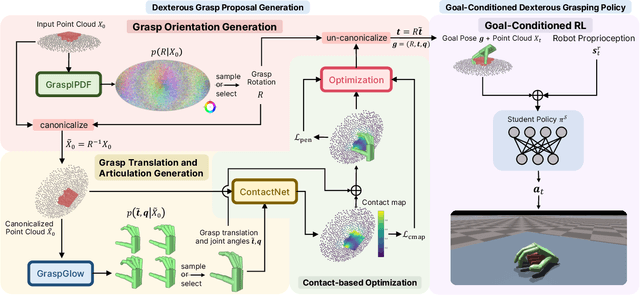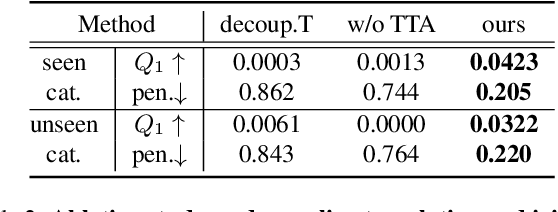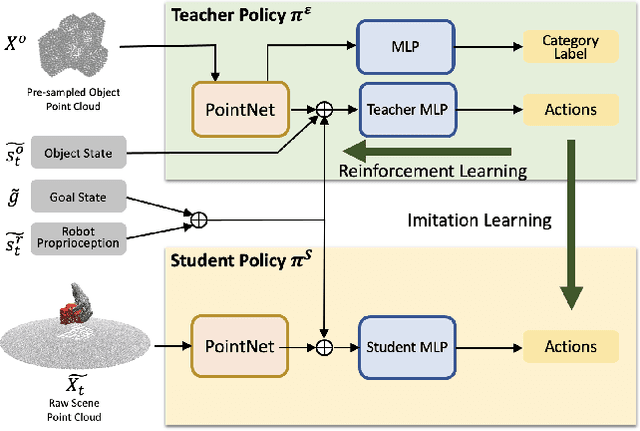Yijia Weng
Feature4X: Bridging Any Monocular Video to 4D Agentic AI with Versatile Gaussian Feature Fields
Mar 26, 2025Abstract:Recent advancements in 2D and multimodal models have achieved remarkable success by leveraging large-scale training on extensive datasets. However, extending these achievements to enable free-form interactions and high-level semantic operations with complex 3D/4D scenes remains challenging. This difficulty stems from the limited availability of large-scale, annotated 3D/4D or multi-view datasets, which are crucial for generalizable vision and language tasks such as open-vocabulary and prompt-based segmentation, language-guided editing, and visual question answering (VQA). In this paper, we introduce Feature4X, a universal framework designed to extend any functionality from 2D vision foundation model into the 4D realm, using only monocular video input, which is widely available from user-generated content. The "X" in Feature4X represents its versatility, enabling any task through adaptable, model-conditioned 4D feature field distillation. At the core of our framework is a dynamic optimization strategy that unifies multiple model capabilities into a single representation. Additionally, to the best of our knowledge, Feature4X is the first method to distill and lift the features of video foundation models (e.g. SAM2, InternVideo2) into an explicit 4D feature field using Gaussian Splatting. Our experiments showcase novel view segment anything, geometric and appearance scene editing, and free-form VQA across all time steps, empowered by LLMs in feedback loops. These advancements broaden the scope of agentic AI applications by providing a foundation for scalable, contextually and spatiotemporally aware systems capable of immersive dynamic 4D scene interaction.
Real2Code: Reconstruct Articulated Objects via Code Generation
Jun 12, 2024



Abstract:We present Real2Code, a novel approach to reconstructing articulated objects via code generation. Given visual observations of an object, we first reconstruct its part geometry using an image segmentation model and a shape completion model. We then represent the object parts with oriented bounding boxes, which are input to a fine-tuned large language model (LLM) to predict joint articulation as code. By leveraging pre-trained vision and language models, our approach scales elegantly with the number of articulated parts, and generalizes from synthetic training data to real world objects in unstructured environments. Experimental results demonstrate that Real2Code significantly outperforms previous state-of-the-art in reconstruction accuracy, and is the first approach to extrapolate beyond objects' structural complexity in the training set, and reconstructs objects with up to 10 articulated parts. When incorporated with a stereo reconstruction model, Real2Code also generalizes to real world objects from a handful of multi-view RGB images, without the need for depth or camera information.
MoSca: Dynamic Gaussian Fusion from Casual Videos via 4D Motion Scaffolds
May 27, 2024Abstract:We introduce 4D Motion Scaffolds (MoSca), a neural information processing system designed to reconstruct and synthesize novel views of dynamic scenes from monocular videos captured casually in the wild. To address such a challenging and ill-posed inverse problem, we leverage prior knowledge from foundational vision models, lift the video data to a novel Motion Scaffold (MoSca) representation, which compactly and smoothly encodes the underlying motions / deformations. The scene geometry and appearance are then disentangled from the deformation field, and are encoded by globally fusing the Gaussians anchored onto the MoSca and optimized via Gaussian Splatting. Additionally, camera poses can be seamlessly initialized and refined during the dynamic rendering process, without the need for other pose estimation tools. Experiments demonstrate state-of-the-art performance on dynamic rendering benchmarks.
Neural Implicit Representation for Building Digital Twins of Unknown Articulated Objects
Apr 01, 2024Abstract:We address the problem of building digital twins of unknown articulated objects from two RGBD scans of the object at different articulation states. We decompose the problem into two stages, each addressing distinct aspects. Our method first reconstructs object-level shape at each state, then recovers the underlying articulation model including part segmentation and joint articulations that associate the two states. By explicitly modeling point-level correspondences and exploiting cues from images, 3D reconstructions, and kinematics, our method yields more accurate and stable results compared to prior work. It also handles more than one movable part and does not rely on any object shape or structure priors. Project page: https://github.com/NVlabs/DigitalTwinArt
Towards Learning Geometric Eigen-Lengths Crucial for Fitting Tasks
Dec 25, 2023Abstract:Some extremely low-dimensional yet crucial geometric eigen-lengths often determine the success of some geometric tasks. For example, the height of an object is important to measure to check if it can fit between the shelves of a cabinet, while the width of a couch is crucial when trying to move it through a doorway. Humans have materialized such crucial geometric eigen-lengths in common sense since they are very useful in serving as succinct yet effective, highly interpretable, and universal object representations. However, it remains obscure and underexplored if learning systems can be equipped with similar capabilities of automatically discovering such key geometric quantities from doing tasks. In this work, we therefore for the first time formulate and propose a novel learning problem on this question and set up a benchmark suite including tasks, data, and evaluation metrics for studying the problem. We focus on a family of common fitting tasks as the testbed for the proposed learning problem. We explore potential solutions and demonstrate the feasibility of learning eigen-lengths from simply observing successful and failed fitting trials. We also attempt geometric grounding for more accurate eigen-length measurement and study the reusability of the learned eigen-lengths across multiple tasks. Our work marks the first exploratory step toward learning crucial geometric eigen-lengths and we hope it can inspire future research in tackling this important yet underexplored problem.
* ICML 2023. Project page: https://yijiaweng.github.io/geo-eigen-length
AO-Grasp: Articulated Object Grasp Generation
Oct 24, 2023Abstract:We introduce AO-Grasp, a grasp proposal method that generates stable and actionable 6 degree-of-freedom grasps for articulated objects. Our generated grasps enable robots to interact with articulated objects, such as opening and closing cabinets and appliances. Given a segmented partial point cloud of a single articulated object, AO-Grasp predicts the best grasp points on the object with a novel Actionable Grasp Point Predictor model and then finds corresponding grasp orientations for each point by leveraging a state-of-the-art rigid object grasping method. We train AO-Grasp on our new AO-Grasp Dataset, which contains 48K actionable parallel-jaw grasps on synthetic articulated objects. In simulation, AO-Grasp achieves higher grasp success rates than existing rigid object grasping and articulated object interaction baselines on both train and test categories. Additionally, we evaluate AO-Grasp on 120 realworld scenes of objects with varied geometries, articulation axes, and joint states, where AO-Grasp produces successful grasps on 67.5% of scenes, while the baseline only produces successful grasps on 33.3% of scenes.
UniDexGrasp: Universal Robotic Dexterous Grasping via Learning Diverse Proposal Generation and Goal-Conditioned Policy
Mar 02, 2023



Abstract:In this work, we tackle the problem of learning universal robotic dexterous grasping from a point cloud observation under a table-top setting. The goal is to grasp and lift up objects in high-quality and diverse ways and generalize across hundreds of categories and even the unseen. Inspired by successful pipelines used in parallel gripper grasping, we split the task into two stages: 1) grasp proposal (pose) generation and 2) goal-conditioned grasp execution. For the first stage, we propose a novel probabilistic model of grasp pose conditioned on the point cloud observation that factorizes rotation from translation and articulation. Trained on our synthesized large-scale dexterous grasp dataset, this model enables us to sample diverse and high-quality dexterous grasp poses for the object in the point cloud. For the second stage, we propose to replace the motion planning used in parallel gripper grasping with a goal-conditioned grasp policy, due to the complexity involved in dexterous grasping execution. Note that it is very challenging to learn this highly generalizable grasp policy that only takes realistic inputs without oracle states. We thus propose several important innovations, including state canonicalization, object curriculum, and teacher-student distillation. Integrating the two stages, our final pipeline becomes the first to achieve universal generalization for dexterous grasping, demonstrating an average success rate of more than 60% on thousands of object instances, which significantly out performs all baselines, meanwhile showing only a minimal generalization gap.
Tracking and Reconstructing Hand Object Interactions from Point Cloud Sequences in the Wild
Sep 24, 2022



Abstract:In this work, we tackle the challenging task of jointly tracking hand object pose and reconstructing their shapes from depth point cloud sequences in the wild, given the initial poses at frame 0. We for the first time propose a point cloud based hand joint tracking network, HandTrackNet, to estimate the inter-frame hand joint motion. Our HandTrackNet proposes a novel hand pose canonicalization module to ease the tracking task, yielding accurate and robust hand joint tracking. Our pipeline then reconstructs the full hand via converting the predicted hand joints into a template-based parametric hand model MANO. For object tracking, we devise a simple yet effective module that estimates the object SDF from the first frame and performs optimization-based tracking. Finally, a joint optimization step is adopted to perform joint hand and object reasoning, which alleviates the occlusion-induced ambiguity and further refines the hand pose. During training, the whole pipeline only sees purely synthetic data, which are synthesized with sufficient variations and by depth simulation for the ease of generalization. The whole pipeline is pertinent to the generalization gaps and thus directly transferable to real in-the-wild data. We evaluate our method on two real hand object interaction datasets, e.g. HO3D and DexYCB, without any finetuning. Our experiments demonstrate that the proposed method significantly outperforms the previous state-of-the-art depth-based hand and object pose estimation and tracking methods, running at a frame rate of 9 FPS.
Leveraging SE(3) Equivariance for Self-Supervised Category-Level Object Pose Estimation
Oct 30, 2021



Abstract:Category-level object pose estimation aims to find 6D object poses of previously unseen object instances from known categories without access to object CAD models. To reduce the huge amount of pose annotations needed for category-level learning, we propose for the first time a self-supervised learning framework to estimate category-level 6D object pose from single 3D point clouds.During training, our method assumes no ground-truth pose annotations, no CAD models, and no multi-view supervision. The key to our method is to disentangle shape and pose through an invariant shape reconstruction module and an equivariant pose estimation module, empowered by SE(3) equivariant point cloud networks.The invariant shape reconstruction module learns to perform aligned reconstructions, yielding a category-level reference frame without using any annotations. In addition, the equivariant pose estimation module achieves category-level pose estimation accuracy that is comparable to some fully supervised methods. Extensive experiments demonstrate the effectiveness of our approach on both complete and partial depth point clouds from the ModelNet40 benchmark, and on real depth point clouds from the NOCS-REAL 275 dataset. The project page with code and visualizations can be found at: https://dragonlong.github.io/equi-pose.
CAPTRA: CAtegory-level Pose Tracking for Rigid and Articulated Objects from Point Clouds
Apr 08, 2021



Abstract:In this work, we tackle the problem of category-level online pose tracking of objects from point cloud sequences. For the first time, we propose a unified framework that can handle 9DoF pose tracking for novel rigid object instances as well as per-part pose tracking for articulated objects from known categories. Here the 9DoF pose, comprising 6D pose and 3D size, is equivalent to a 3D amodal bounding box representation with free 6D pose. Given the depth point cloud at the current frame and the estimated pose from the last frame, our novel end-to-end pipeline learns to accurately update the pose. Our pipeline is composed of three modules: 1) a pose canonicalization module that normalizes the pose of the input depth point cloud; 2) RotationNet, a module that directly regresses small interframe delta rotations; and 3) CoordinateNet, a module that predicts the normalized coordinates and segmentation, enabling analytical computation of the 3D size and translation. Leveraging the small pose regime in the pose-canonicalized point clouds, our method integrates the best of both worlds by combining dense coordinate prediction and direct rotation regression, thus yielding an end-to-end differentiable pipeline optimized for 9DoF pose accuracy (without using non-differentiable RANSAC). Our extensive experiments demonstrate that our method achieves new state-of-the-art performance on category-level rigid object pose (NOCS-REAL275) and articulated object pose benchmarks (SAPIEN , BMVC) at the fastest FPS ~12.
 Add to Chrome
Add to Chrome Add to Firefox
Add to Firefox Add to Edge
Add to Edge